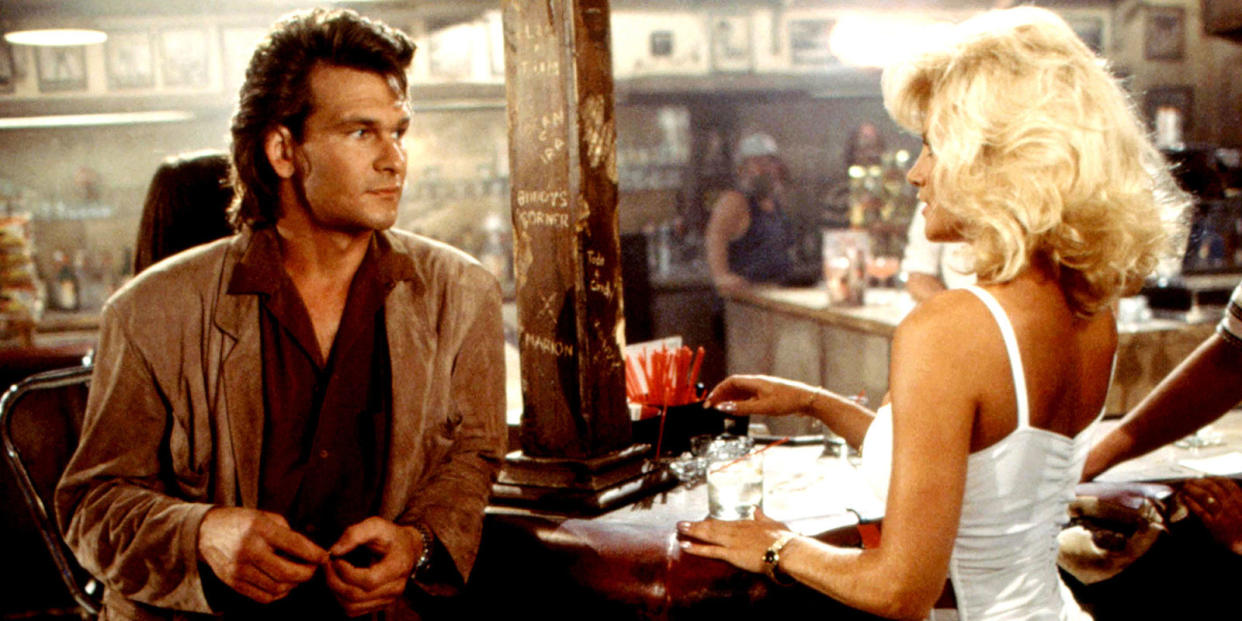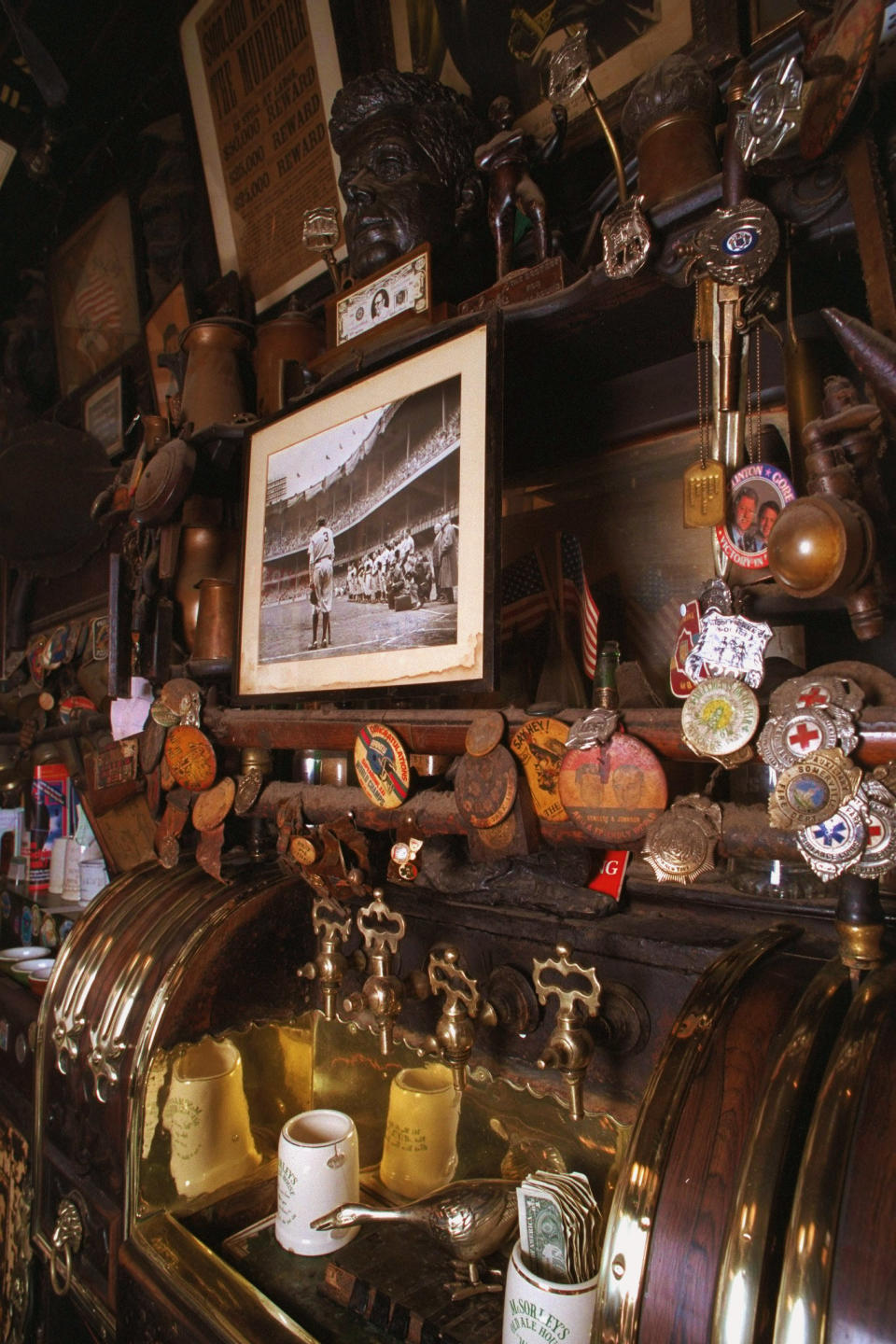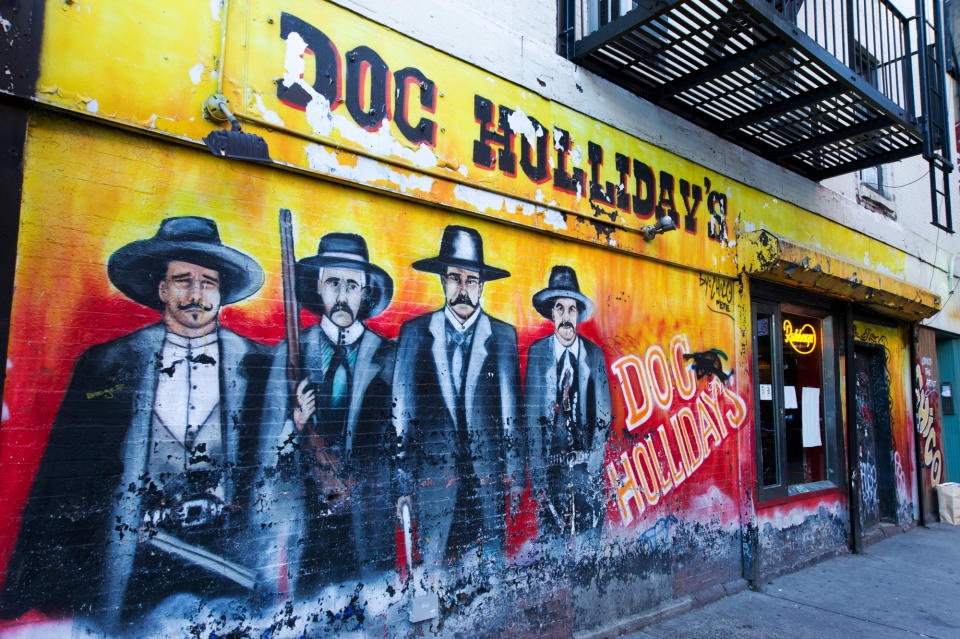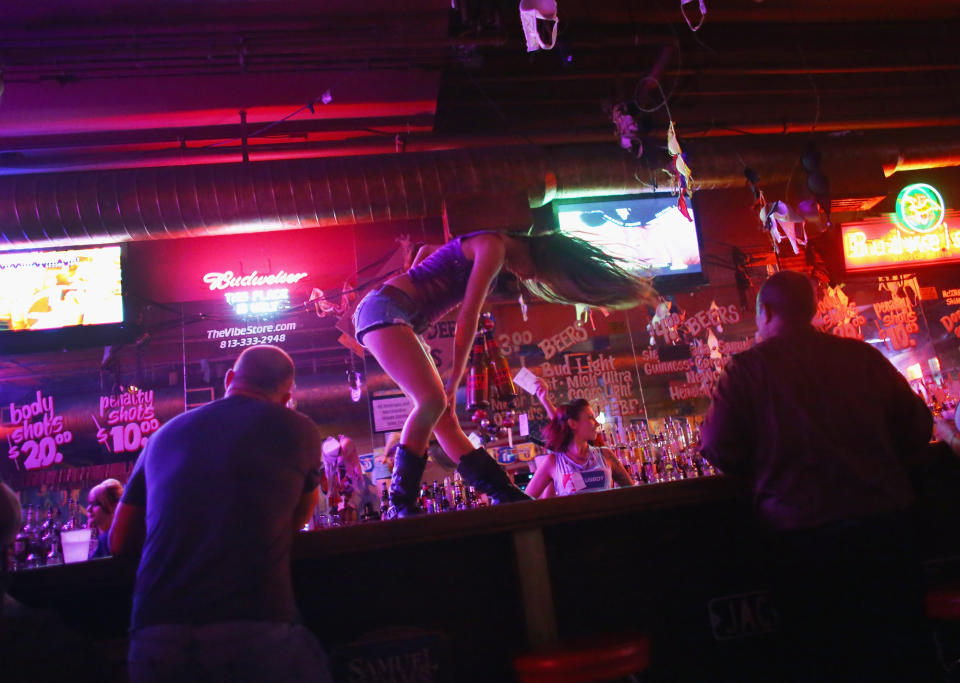In Search of the Dirtiest Bars in New York

The Ridgeway Diner in Manhattan has "filth flies or food/refuse/sewage-associated flies present," according to the New York City Health Department. Yet I still chose to sit down at the bar in the empty Greek diner. No, that's why I chose to sit down at the bar, munching on chicken souvlaki and drinking cheap whiskey. I was looking for the city's truly diviest places to drink-it's absolutely dirtiest establishments.
A lot of upwardly mobile urbanites like to fetishize dive bars, myself included. Food and drink publications make listicles. But today's hip "dives" aren't really dives. They're ersatz, generally safe, clean-enough places to slum it. It's like that great line from The Simpsons, when a yuppie walks into Moe's Tavern and, with disgust, exclaims, "This isn't faux-dive...this is a dive!" Except, you know, in reverse.

This always bothered me. If a place to drink isn't dirty, can it really be a dive? Then again, is simply being dirty enough to make something a dive? Maybe a dive doesn't even need to be a bar. I wanted to explore New York City's real dives, and I figured I could start at the most disgusting spots in the five boroughs, the ones that would never make a damn listicle. Luckily, there's a great website called Safe Dining in NYC that overlays Health Department (DOH) ratings on a city map. If you didn't know, all establishments in New York that serve food-yes, beer is food-are subject to a yearly health inspection. They are then issued a "Sanitary Inspection Grade" on a scale of A (good) to C (fucking disgusting), which must be prominently displayed in their front windows. Safe Dining logs all these scores, supposedly, in real time, along with each violation recorded. (And now that you know about it, I guarantee you're going to waste the next hour playing "Oh, really, that place has roaches?")
According to the site, of the more than 25,000 joints in New York there are only 103 currently rated a "C." So I headed out with my airport terminal bar-crawling buddy, Dave. Our first stop was the Ridgeway Diner. Work had just ended, and we were hungry. Still, on a chilly Monday evening, the place was completely empty; I couldn't even see anyone working in the open kitchen. Maybe clientele and workers were spooked by "conditions conducive to attracting vermin to the premises." It didn't feel too dirty. The floors were mopped, the counters Lysoled, the plates sparkling white. Even the bathroom didn't gross me out, though it was as cold as a walk-in cooler. Dave and I were closest thing to "vermin" I saw.
If a place to drink isn't dirty, can it really be a dive?
Still, drinking almost alone in the harshly-lit diner, I felt quite uneasy. Maybe that was because the spiral-bound menu had a whole page dedicated to a Long Island-based personal injury attorney. Maybe it was the incessant one-on-one attention the counter man gave us (he handed both Dave and I our own full bottles of ketchup and hot sauce). But, hey, isn't that what a good dive should create in you? A little fear, a little concern, a whole lot of worry about what is currently lingering out of site and below the surface. It felt thrilling, death-defying even, like a rickety carnival rollercoaster. You just don't get that feeling in faux-dives. So was it possible this subpar, if mostly clean, Greek diner was actually a really great dive?
The Dirtiest of the Dirty Bars
We headed to the East Village's Brindle Room, a C-rated gastropub that in the last year has been dinged for "live roaches present in facility's food and/or non-food areas." We didn't need any more food, and drinking in the "non-food" area seemed fine. The beer list was solid, and they offered a cocktail called the Donkey Punch. The bar was mostly filled with young professionals, likely blissfully unaware the bar had, or has, roaches. If this bar was indeed dirty, I wouldn't call it a dive; they served spicy calamari and duck confit poutine, and I feel quite at ease.

Another "C," a large beer hall called Arrogant Swine I've frequently drunk heavily at, didn't seem like a dive either. Besides a large craft beer tap list, it also has terrific North Carolina BBQ and serves a decadent waffle-pressed mac 'n' cheese. (Owner Tyson Ho wrote about the bullshit of DOH grades back in 2014.) The only thing that makes it anything like a dive is that it's on one of those streets in Brooklyn that looks desolate and dangerous, but actually has $4 million loft apartments right above street level.
The Upper East Side's legendary JG Melon is oldish (est. 1972), which is often one parameter for being a dive. It's also cash-only, another usual characteristic. Still, few would consider the legendary burger bar a dive despite having recently received a "C" rating and a litany of violations that include "sewage disposal system in disrepair or not functioning properly." When I visited for lunch the next day, I found a man mopping the floor ahead of the arriving guests. The bar was historic, my Montauk Ale was refreshing, and the bathroom was clean as a whistle.
Conventional wisdom argues all dives must surely be dirty. Ahead of even cheap drinks, isn't that the biggest prerequisite? I would never, for instance, change my baby's diaper in a dive bar bathroom, or eat the help-yourself pub mix on the bar top that all the unsavory customers already fondled. So what makes a dirty bar a dive? Is it just a know-it-when-ya'-see-it sort of thing?
Still Not Seeing It
Forgetting the letter grades for a second, Dave and I decided to check out some nearby bars that everyone considers unquestionable dives. Walking down First Avenue, we cracked the door and peeked into Coyote Ugly-who knew that was still a thing? A scantily-clad woman was dancing in her heels on the same bar people eat and drink off of, yet an "A" was still prominently displayed in the window. We considered Blue & Gold Tavern with its neon markerboard menu written in a childish scrawl. It's a bar so dark you can't tell if it's squalid, and such a dive they somehow manage to sell single-malt scotch for five bucks a glass despite the real estate costs of the area. It too got an "A."
I would never, for instance, change my baby's diaper in a dive bar bathroom, or eat the help-yourself pub mix on the bar top.
We finally entered Doc Holliday's, a place I used to frequent in my early 20s-not because I liked sitting on skid row, but because PBR pounder cans were only $2. "A Boy Named Sue" was playing on the jukebox, a perfectly dirty song for this dirty bar ("Kicking and a' gouging in the mud and the blood and the beer…") Yes, the joint was just as disgusting as I recalled, still smelling like a mix of stale beer and public swimming pool, still looking like the kind of place one enters to get into a brawl over a $1 game of pool. Even worse, the best deal on the menu these days is the $7(!) tallboys of Labatt Blue. Shockingly, though, Doc Holliday's also got an "A."
I looked closer and noticed Doc Holliday's floor was actually pretty clean. I wouldn't eat off it, but it wasn't so bad that I'd have to upgrade to a new iPhone were it to hit the ground. In fact, most of the city's most famous dives, the ones that make all those lists, got an "A." Like McSorley's, whose walls are made of 160 years worth of dust. Or Jeremy's Ale House, where I once entered the bathroom to find a sink filled to the brim with vomit. Even Rudy's, which offers free hot dogs that Time Out New York claims you should only eat "if you dare." In fact, I struggled to find a single "famous" dive that got anything less than an "A."

You'd almost think proud dives would eschew an "A" grade. How punk rock of them would it be to proudly display their "C"? To lobby for an "F" to be added to the grading scale, even? Still, even dives are owned by businessmen who need their establishments to stay open. Indeed, I later learned the owner of Doc Holliday's owns four other bars in the neighborhood, like d.b.a., which is hardly dirty or divey-I took my wife there on an early date.
Many of the so-called "dirtiest" establishments on the Safe Dining list seemed to be Chinese restaurants, with names like Savour Sichuan, Mr. Wonton, and China Green. Biased and problematic, evidence of cultural miscommunication, or a true health hazard, I'm not the one to say. I just needed to drink at one. I headed to a place in my Brooklyn neighborhood with such infractions as "wiping cloths soiled" and "tobacco use... in food preparation, food storage or dishwashing area observed." I'm not sure I'd ever drunk at a Chinese restaurant. Indeed, the hostess at this particular establishment seemed surprised when I asked to sit at the small bar and have a beer alongside some egg drop soup. She had to clear papers off the bar top; they'd been using it as an impromptu office desk. There wasn't a menu, but I learned my options were purely macro-swill bottles. (Comparatively, most of today's famed dive bars now have a craft IPA or two on tap.)
How punk rock of them would it be to proudly display their C? To lobby for an "F" to be added to the grading scale, even?
The lack of anything to look at as I drank, the inability to mindlessly watch SportsCenter, and the general emptiness of the place made that feeling of uneasiness from the Ridgeway Diner return. The employees stared at me. The delivery boys in the foyer, waiting to be sent out, wondered who I was-possibly the health inspector? I sucked down my Tsingtao as fast as I could, wondering if this Chinese restaurant was the city's truest dive. But the next time I walked past the restaurant, I noticed it was upgraded to a "B."
'Clean' Is a Matter of Opinion
The famed dive bars that make lists are often in pricey, gentrified neighborhoods. They serve fancy IPAs, and not for all that cheaply. Your chances of getting in a fight or being thrown up on have greatly decreased. A good portion of the clientele can even afford to go have a $15 cocktail if they actually want to, are Instagramming the beat-up bar for shits and giggles, and are none the dirtier for it.
Back in 2010, when the DOH introduced mandatory letter grades, many bar and restaurant owners thought it unfair. Several years later, it hardly seems oppressive. If anything, the DOH has worse grade inflation than Harvard. The reason you see so few Bs and Cs around the city is not because they don't exist, but rather because any place that gets those scores has a one-month grace period to quickly clean up their act for a re-inspection. As restaurateur Marc Murphy told CBS News, "Either you're clean enough to operate and you're legal, or you're closed. Close the restaurants that are dirty."
As FiveThirtyEight found, however, even when you're clean, you're kind of dirty. An "A" simply means an establishment received 13 or fewer health code violations in their last inspection. 13! FiveThirtyEight located a Brooklyn café where the health inspector "found droppings from mice, rats, roaches and flies." Still, the spot amassed a mere 11 points, which was good enough for an "A." Of course, if every joint in New York is actually dirty, then maybe every joint in New York is actually a dive.
You Might Also Like

